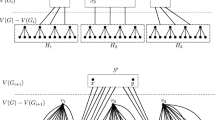Abstract
Steinberg-type graphs, those planar graphs containing no 4-cycles or 5-cycles, became well known with the 1976 Steinberg Conjecture which stated that such graphs are properly 3-colorable. Recently, Steinberg’s Conjecture was demonstrated to be false (Cohen-Addad et al. in J Combin Theory Ser B 122: 452–456, 2016). However, Steinberg-type graphs are (3, 0, 0)-defective colorable (Hill et al. in Discrete Math 313:2312–2317, 2013), i. e. of the three colors, two are used properly and any vertex colored with the first color is allowed to be adjacent to up to three other veritces with the same color. In this paper, we introduce a stronger form of defective graph coloring that places limits on the permitted defects in a coloring. Using the strength of this new type of coloring, we prove the current closest result to Steinberg’s original conjecture and show that the counterexample given in Cohen-Addad et al. (J Combin Theory Ser B 122:452–456,2016) is colorable with this stronger form of defective 3-coloring.










Similar content being viewed by others
References
Appel K, Haken W (1977) Every planar map is four colorable. Illinois J Math Parts I II 21:429–567
Bopche G, Mehtrea M (2017) Graph similarity metrics for assessing temporal changes in attack surface of dynamic networks. Comput Secur 64:16–43
Borodin OV, Glebov AN, Raspaud A, Salavatipour MR (2005) Planar graphs without cycles of length from 4 to 7 are 3-colorable. J Combin Theory Ser B 93:303–311
Cohen-Addad V, Hebdigeb M, Kráil D, Lia Z, Salgadode E (2016) Steinberg’s Conjecture is False. J Combin Theory Ser B 122:452–456
Cowen LJ, Cowen RH, Woodall DR (1986) Defective colorings of graphs in surfaces: partitions into subgraphs of bounded valency. J Gr Theory 10:187–195
Chen M, Wang Y, Liu P, Xu J (2016) Planar graphs without cycles of length 4 or 5 are \((2,0,0)\)-colorable. Discrete Math 339:886–905
Grünbaum B (1964) Grötzsch theorem on 3-colorings. Michigan Math J 10:303–310
Jensen T, Toft B (1995) Gr Color Probl. Wiley, New York
Miao Z, Wang Y, Xu L (2014) Every planar graph with cycles of length neither 4 nor 5 is \((1,1,0)\)-colorable. J Comb Optim 28:774–786
Robertson N, Sanders D, Seymour P, Thomas R (1996) A new proof of the four color theorem. Electron Res Announc Am Math Soc 2:17–25
Shehab M, Squincciarini A, Anh G, Kokkinoud I (2012) Access control for online social networks third party applications. Comput Secur 31:897–911
Hill O, Smith D, Wang Y, Xu L, Yu G (2013) Planar graphs without cycles of length 4 or 5 are (3,0,0)-colorable. Discrete Math 313:2312–2317
Steinberg R (1993) The state of the three color problem. Quo vadis, graph theory? Ann Discrete Math 55:211–248
Acknowledgements
We are grateful to our institutions, Norwich University and the University of Rhode Island, for supporting this research. The work was made possible, in part, by a Norwich University Chase Research Release award for the first author. We would also like to thank the anonymous referees for their helpful suggestions in clarifying parts of the paper.
Author information
Authors and Affiliations
Corresponding author
Additional information
Publisher's Note
Springer Nature remains neutral with regard to jurisdictional claims in published maps and institutional affiliations.
Rights and permissions
About this article
Cite this article
Armstrong, A., Eaton, N. New restrictions on defective coloring with applications to steinberg-type graphs. J Comb Optim 40, 181–204 (2020). https://doi.org/10.1007/s10878-020-00573-5
Published:
Issue Date:
DOI: https://doi.org/10.1007/s10878-020-00573-5




